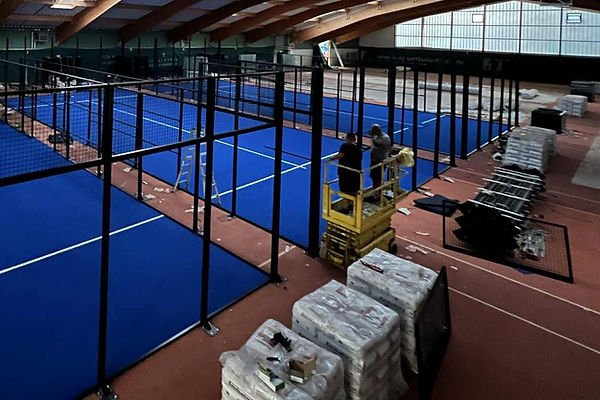
Padel Court Architecture: Key Considerations

At first glance, indoor and outdoor padel courts can appear identical, but their engineering and operational demands differ dramatically. Use four fundamentals to steer decisions: planning, acoustics, consistent play, and durability.
Glass remains the benchmark for playability, while hybrid and modular systems add flexibility; masonry can lower capex but introduces gameplay variance. Site context drives choices: outdoors prioritize wind resistance, UV exposure, drainage, and neighbor impact; indoors prioritize clear height, echo control, lighting uniformity, and climate management. Lock specifications early to protect ROI and ensure the court performs as intended over its full life cycle.
Key Considerations by Padel Courts
1) Padel Court Planning Mistakes Are Hard to Fix
Plan for structural loads (steel + glass), wind and drainage (outdoor), clear height (≈6–8 m indoor), safe run-offs, lighting orientation, and permits. Lock specs early to avoid redesigns.
Outdoor: Engineer for wind/snow loads, galvanic protection, drainage, sun path (N–S orientation), neighbourhood constraints.
Indoor: Verify roof height, ventilation/HVAC, glare control, acoustic treatment, and slab flatness.
Practical recommendations:
-
Engage padel specialists in pre-design.
-
Specify performance (wind class, glass thickness/lamination, corrosion class), not vague standards.
-
Use contractors with proven padel installs.
2) Court Acoustics: Critical Yet Underestimated
Glass is loud; multi-court halls amplify echo and can affect neighbours. Treat acoustics in concept, not as an afterthought.
Outdoor: Use site layout, landscaping, barriers/windscreens, and hours policies to limit spill; orient glass away from residences.
Indoor: Add absorption (ceiling baffles, wall panels, curtains), break up parallel hard surfaces, and isolate structural vibrations.
Practical recommendations:
-
Model sound early for sensitive sites.
-
Combine orientation + barriers outside; absorption + diffusion inside.
-
Set operating hours where required.
3) Playing Characteristics: Walls & Surface
Tempered (or laminated) glass gives predictable rebounds; clean seams and plumb panels matter. Sand-filled synthetic turf delivers safe grip and medium pace; keep infill even.
Outdoor: Manage wind (screens/partial enclosures), glare (orientation/shade), heat (light turf, hydration breaks).
Indoor: Ensure uniform lighting, stable climate, and anti-glare optics; maintain ball visibility on glass.
Practical recommendations:
-
Choose certified systems with uniform rebound.
-
Specify quality turf; maintain infill levels and brushing.
-
Consider anti-glare/anti-scratch options for premium use.
4) Durability: Built for Weather and Wear
Protect frames from corrosion, glass from thermal/wind stress, and turf from UV and compaction; align warranties with ROI.
Outdoor: Galvanized/powder-coated steel, sealed anchors, UV-stable turf, drainage, periodic anti-rust touch-ups.
Indoor: Monitor condensation points, hardware loosening from vibration, and dust on lighting/ceilings.
Practical recommendations:
-
12 mm (outdoor) or 10 mm (indoor) tempered or laminated safety glass (keep one spare panel if feasible).
-
Annual inspections; documented maintenance plan.
-
Warranties ≥10 years on structure; planned turf refresh cycles.